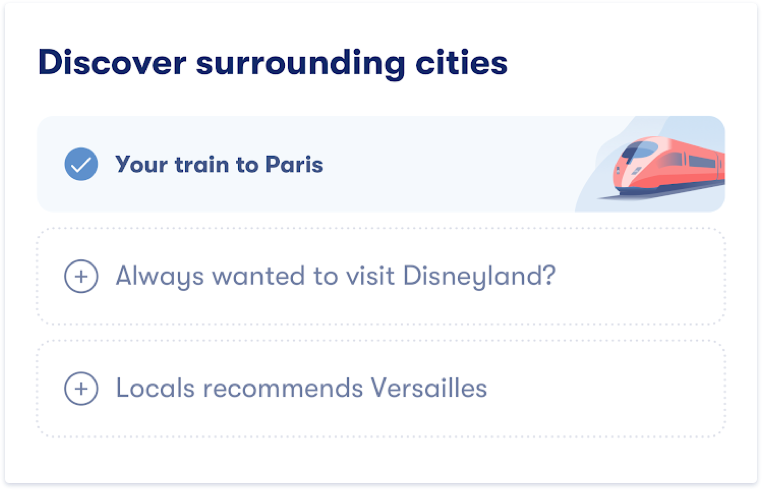Omio - Onward Journey reccomendations
Problem:
Omio wants to capture every travel booking an individual makes (global inventory, all in one Platform). We have observed that searching and booking travel is rarely linear and often done in multiple steps across a larger ecosystem. Often people make single bookings that will eventually form a longer chain of bookings, or book an individual trip and later book smaller trips to surrounding locations. People jump between sites and apps looking for inspiration of what to do next. This single booking behaviour, and abandonment of Omio immediately post booking, means Omio does not necessarily capture all bookings an individual makes.
Hypothesis:
We believe that providing relevant recommendations for onward trips post booking will inspire people to make further bookings with Omio. We will know we’re right when we see an increase in the percentage of customers making a second booking within 24 hours
My Role:
I led a team of three great designers through this project. They are responsible for all of the beautiful UI’s shown here. My role was to oversee all design activities to ensure we produced a compelling and consistent user experience. I structured the project, working closely with user research, product management, engineering and data science. I worked closely with all the designers through out the process, leading ideation sessions, helping to sketch initial design ideas and providing creative direction throughout the project.
Insights synthesis:
We had a lot of insightful quantitive research informing this project. We began a synthesis phase, delving into the analytics to understand the current behaviour, building clusters and identify/size opportunities. We defined Onward Journeys as connected bookings made within 90 days of a One-way booking. These tend to be multiple stop trips or trips that use a destination as a hub to explore surrounding areas.
Target clusters:
It was very evident from the analytics that our target for these types of bookings were unfamiliar International travellers, we could see in our data that they were substantially more likely to continue on to a new destination after a booking. Most onwards bookings are made before departure, a large majority of these are made within 48h of the first booking,
Opportunity areas:
The biggest opportunity area seemed to be a short window post purchase. I facilitated a cross functional workshop where we walked through the entire end to end booking experience, web, app and CRM. The aim was to pinpoint where in the product we had opportunities to recommend onward journeys.
Recommendations:
It was also evident in our analytics that there were significants trends in onwards bookings. We could see that when people booked a certain trip, it was highly likely that we could predict their next trip. For example if they booked from Budapest to Vienna, it was likely that their next booking would be Prague, Salzburg or Bratislava.
Ideation Phase:
Once we had a clear understanding of the problem we were trying to solve and opportunity areas in the product we began to ideate, exploring a wide variety of potential design solutions. We began design explorations for four main parts of the product: booking success on web, booking details on the app, home screen on app and the post booking emails.













Research:
The deadlines for the project were tight, we wanted to bring all these features to market in six weeks, so we ran this a little like a Google Design Sprint. Every week we brought in 6 people and ran in house moderated user tests. This allowed us to get clear data from a realistic prototype quickly.
The research was designed as a concept test. We built prototypes that gave users a rough approximation of the feature in order to understand if they might use it. We were also able to gather valuable feedback about things like copy and interactions.
Implementation Phase:
Once we had converged on the MVP version, I worked closely with the PM’s to design the A/B test and ensure we were measuring everything we needed to in the feature. We use Amplitude to track interactions and funnels.
We saw a good engagement with the Onward Journey recommendations. Roughly speaking the features were driving a few thousand bookings a day.
However the global lock down and huge reduction in travel has not allowed us to get a complete picture of how successful these features are yet. To fully understand the impact we need to analyse the 24 attach rate (% of customers making a second booking within 24 hours) and the effect on 90 day retention (% of customers making a second booking within 90 days - excl. First 24 hours post purchase). Without these we are unsure if the features are creating new bookings or simply cannibalising bookings that a user would have made anyway.
We will have to wait for the true impact but this has given us a taste of the future. We’ve learnt a huge amount recommending trips and will hopefully continue to iterate these features in the future.




